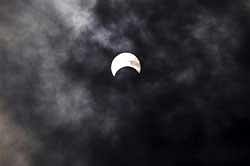

The millennium's longest solar eclipse gave a unique chance to ISRO scientists and astronomy lovers to study the event on Fridaytoday, with the space agency launching rockets and celestial gazers aiming telescopes at the sky to watch the moon's shadow covering the sun.
Vikram Sarabhai Space Centre (VSSC), Thiruvananthapuram launched a series of Rohini Sounding Rockets from TERLS, Thumba, to investigate the effects of the solar eclipse on the atmosphere.
The spectacle began at 11:17 AM at Dhanushkodi island, off Tamil nadu coast, the best location to watch the eclipse.
Four sounding rockets of series RH 200 and RH300MK II with peak altitudes of about 70km and 116 km respectively were launched on Thursday to collect data. This was followed by another five launches today, the eclipse day, an ISRO release said.
Two larger Rohini rockets of the series RH 560 MK II were also launched from the Satish Dhawan Space Centre (SDSC), Sriharikota, yesterday and today, which will have a peak altitude of 548 km.
The occurrence of eclipse will result in a sudden cut-off of solar radiation. This affects the atmospheric structure and dynamics. There will be a large reduction in ionization and temperature, ISRO said.
It is also a unique opportunity to investigate the effects of the fast varying solar flux on the photochemistry and electrodynamics of different atmospheric regions, especially the equatorial mesopause and ionosphere-thermosphere regions, the space agency added in the release.
These experiments will coordinate modern ground-based eclipse observations with in-situ space measurements. Interpretation of eclipse data together with space data will give new insights to the earlier eclipse observations, ISRO said in the release.
As the eclipse began, astronomers -- amateur and professional -- aimed their telescopes to capture every moment of the event.
"We recorded the event in special filters and obtained pictures to study the various aspects of the celestial event," said R C Kapoor, a scientist with the Bangalore-based Indian Institute of Astrophysics (IIA).
Kapoor, along with six colleagues from IIA led by Director Siraj Hasan had made Kanyakumari, where the ring of fire was seen at 1:06 PM, as their base to study the eclipse.
"Observations made during the solar eclipse are important in order to understand the complex processes that heat the Sun's surface," Kapoor said.
The duration of annularity was 10:8 minutes at Kanyakumari, where the magnitude of the eclipse was 94.9 per cent.
In Varkala in Kerala, an NGO, Science Popularisation Association of Communicators and Educators (SPACE) conducted experiments relating to temperature and light variation besides wind speed variations.
"We were able to see the ring of fire when solar eclipse was in its annularity which it in turn provided us an opportunity to do our experiments," C B Devgun, Director SPACE said.
"I think it was fantastic to see the eclipse. Lot of enthusiasm was there in the people who came to witness the celestial phenomenon," Devgun added.
"The amount of new information that you get from a single eclipse is enormous and I think it has an evolutionary impact on science," he said.
As the moon started covering the sun, astronomers from Varkala tried to capture the special phenomenon during the eclipse known as 'Baily's Beads', which occurs when sunlight passes through the moon's uneven surfaces, appearing as 'beads of lights'.
These stunning bead like light formations are created due to light filtering through the hills and valleys of the uneven surface of the moon and are crucial observations which can only be made during eclipses that can help define the solar diameter accurately.